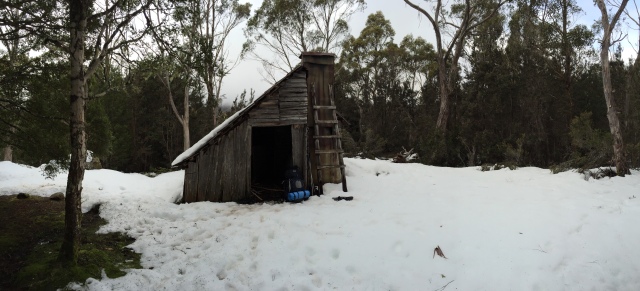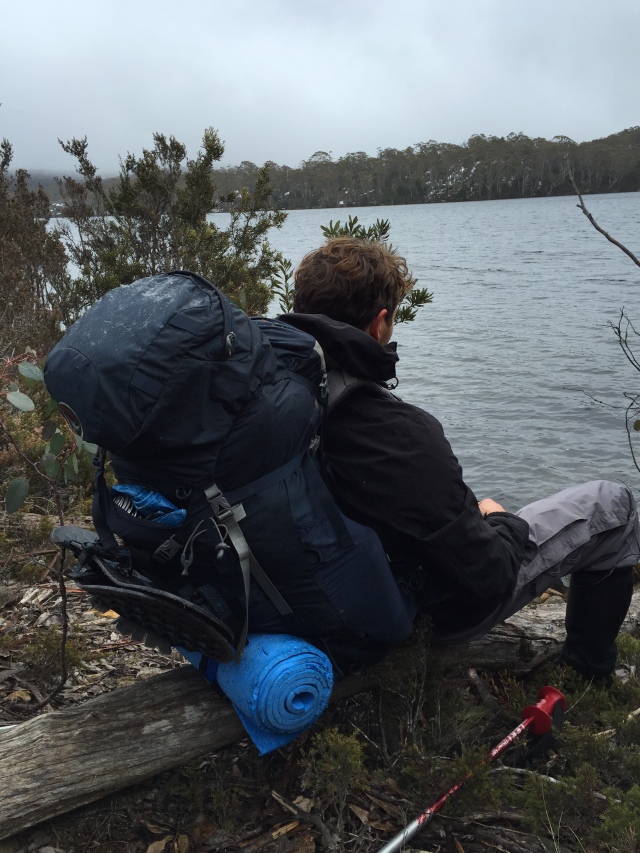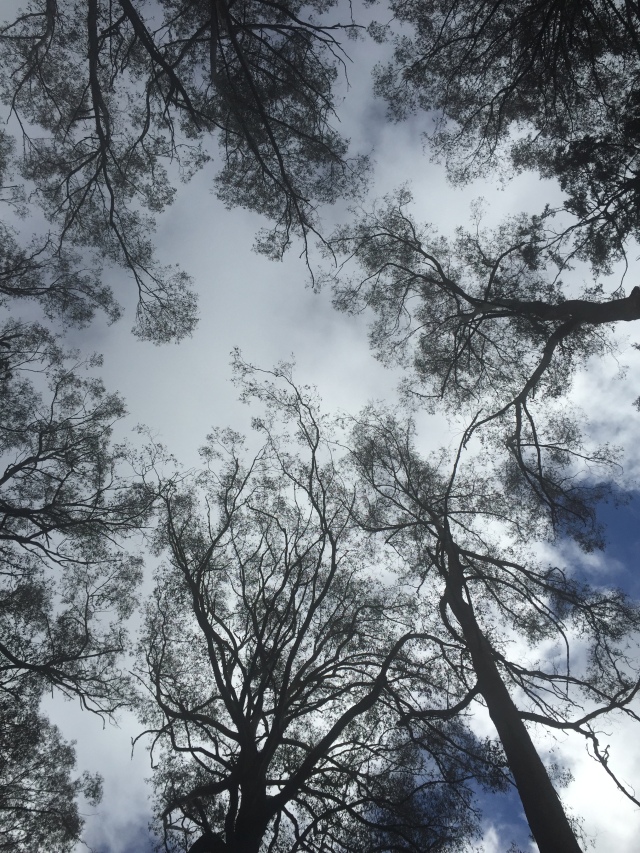By Daniel Frank
Day 1
Crew: Bergman, Doff, Frank and Greenblo.
We were beginning to believe we would have to spend the night out here, perched on the mountainside between trees that were slouching under the weight of snow. It is already dark and there is no prospect of pitching tents on the steep slope. Our goal is Lake Meston Hut. We know we are close but cannot be certain; the trail lost long ago. The little yellow marker on our GPS indicates the hut is surprisingly close; less than 100 footsteps away, but as we strain our eyes we see no evidence of shelter, not even a faint outline. Instead, we are confronted with more of the same black, dense woodland we’ve found ourselves wading through these past few hours. We surge forward in desperation, leap over a small creek and, to our relief, finally find ourselves in a small clearing with the hut its centrepiece. As we enter the ramshackle timber structure, we feel grateful to be here, rewarded for our efforts, and despite its shortcomings, it is a sanctuary for the night.
As we settle in for the evening, I can’t help but reflect on just how far we’d pushed. We are too fatigued for the usual campsite banter, managing only the bare minimum of practical exchanges before drifting off into a deep sleep with thoughts of how we’d reached this point swirling in our minds …
… how differently our first day had begun. We made our way along the arduous and bushy Lake Myrtle Trail. It was mainly ‘off track’, but we had just set off and with energy levels still high we made good progress. As we reached Lake Bill, we caught our first glimpse of the Central Plateau, the heart of Tasmania’s pristine high country. The rocky top of Mt Rogoona lay in the distance and quaggy Lake Bill surrounded by a patchwork of snow. We had passed Lake Myrtle, which glistened in the gentle Tasmanian light. It was prehistoric and both subtly and spectacularly beautiful.
The rest of that day had progressively become more challenging. The snow cover increased and the track disappeared. Our pace slowed to a mere 500 metres an hour, hampered by thick scrub. We pushed on, not knowing just how much tougher the terrain would become. Its difficulty peaked in those final hours and minutes, when we stood in the dead of the night, disoriented but only 100 footsteps from our sanctuary.

Day 2
Faint rays of morning light pierce through cavities in the cabin’s walls and encourage us out of sleeping bags. The hut had afforded us a good night’s rest and served us well, as it had others before us. The logbook shows that we are the first people here in four months! We proudly call ourselves the ‘winter warriors’, though we are not sure if it was bravery or stupidity that drove us to take on the snow and marshland of Tasmania’s Central Plateau.

We start Day 2 much as we had finished the first. The path is unstable in the icy mush, blocked by yet more snow-bent saplings. Our decision to venture up here during winter is being tested. But at least it is relatively flat and we can see picturesque Lake Meston as we push on.
At the northern end of Lake Meston we come across a lovely little campsite, which had clearly been the preferred choice for those sensible enough to choose summer as the season to meander the Walls of Jerusalem National Park. We move passed it and across an undulating snow-covered plain towards Lake Adelaide. It’s black, tannin-stained water constantly draws our gaze as we walk along its eastern edge. It is overcast and spitting but undeniably magnificent. We stop for a lazy lunch on the trail, just a couple of metres from the lake’s shore.

Tonight, we camp by the famous Pencil Pines at the northern end of Lake Adelaide. The trees are so triangular in shape that they look like props from a low-budget Christmas special. The day had been hard but, this time, we reached camp well before dark. We string up a tarp between the trees to protect us from the rain. We joke and laugh, preparing endless cups of tea from lake water that tastes artificially sweet. The isolation, the beauty, and the challenge were sinking in.
Day 3
In the morning we put on our snowshoes in anticipation of yet more snow. But as we scale up a small hill towards Mt Moriah the snow disappears. Taking our snowshoes on and off subject to the conditions had already become a theme of the trip. Depending on the aspect of the hill, the snow would either be non-existent, icy slush or just plain deep.
At the top we encounter another snow-covered plain which leads to the beginning of Lake Ball. Closer to the lake we come across a strange environment of partially submerged, spongy plants with fast flowing rivulets between them. Hopping across we make it to the other side and what we find astounds us. Lake Ball is partially frozen and thick enough to walk on in places. We just didn’t believe this was Australia – it felt like the Patagonian wilds or the Canadian tundra.
The track continues and once again we are on a hillside. It becomes increasingly steep, probably 45 degrees. One false step and you would slide down to the lake shore and perhaps into it. The snow forces us to slam our snowshoes into the side of the hill to get a footing. This became increasingly important as more and more jagged granite rocks started to poke out. Our fear of falling into the lake was replaced by a fear of being impaled. The rocks looked deliberately carved and strategically placed like fortifications intended to keep people away. The weather and the mountains were trying to kill us, this much was clear.
But like the weather on the Plateau, nothing lasts forever and the track once again flattens out. Ahead of us, the gentle incline of Jaffa Vale leads to Dixons Kingdom Hut, perhaps the most famous hut in the park. It is a shallow incline but the going is tough. The snow is uncompacted causing us to drop knee- or even waist-deep into spiky bushes or gaping holes between the vegetation, over and over again.

Arriving at Dixons is bittersweet. Like us, the hut is cold and damp. We eat lunch and watch the rainfall. We are only half way to Wild Dog Creek Camp. Exhausted and freezing, we consider staying the night but decide to push on, ensuring a quicker, earlier exit in the morning.
Just beyond Dixons Kingdom Hut we see deep footsteps imprinted in the snow. Perhaps we aren’t the only crazy people out here, though we’d not actually seen another person since we set out.
Desperate to avoid walking in the dark again we attack the trail and soon enough reach Damascus Gate. The spectacular glory of the main Walls area presents itself: to our left are the imposing cliffs of Solomon’s Throne and King David’s Peak and to our right innumerable lakes, patches of Pencil Pines and a distant stormy horizon. The despair of lunch lifted. The grueling and relentless battle it had been to reach this point was worth it many times over.
We move quickly downhill towards Wild Dog Creek, passing the Pools of Bethesda. Wallabies and wombats casually graze in the bush as we pass. Our third campsite has tent platforms, toilets and tapped water. It feels so developed. There is also a resident possum that is incredibly persistent in its attempts to pilfer our food. The lack of sustenance among the snow made the animal desperate and unperturbed by our shouts and gestures. Everything out here is tough, even the possums.
Just as we finish setting up camp it starts to snow heavily. We have now experienced all types of weather except (thankfully) a severe storm. Tassie’s unpredictable weather is oh so constant.
Day 4
The final leg of our journey passed Trappers Hut is purposeful. There is still plenty of snow but as we descend little streams of water appear, finally converging and turning the track into a fast flowing creek. Despite only being a few degrees above zero it felt decidedly balmy compared to the cold nights. And, just like that we had left the Central Plateau.



















What a wonderful experience and so beautifully documented.A good escape from domesticity.Regards Brian Frank.